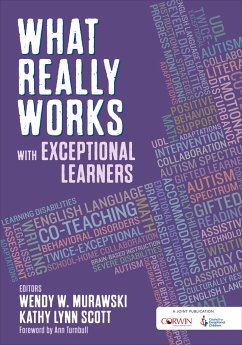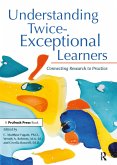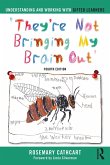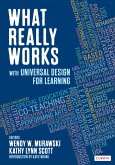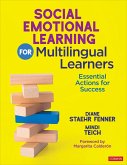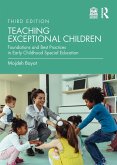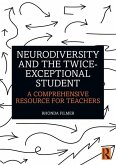What Really Works with Exceptional Learners
Herausgeber: Murawski, Wendy; Scott, Kathy Lynn
What Really Works with Exceptional Learners
Herausgeber: Murawski, Wendy; Scott, Kathy Lynn
- Broschiertes Buch
- Merkliste
- Auf die Merkliste
- Bewerten Bewerten
- Teilen
- Produkt teilen
- Produkterinnerung
- Produkterinnerung
This book provides personal experiences, best practices, and deeper resources for educators who work with students with special needs. Chapters discuss how special educational needs affect reading and math instruction, accommodations, culturally responsive practices, legal issues, home-school collaboration, and more.
Andere Kunden interessierten sich auch für
![Understanding Twice-Exceptional Learners Understanding Twice-Exceptional Learners]() C. Matthew FugateUnderstanding Twice-Exceptional Learners53,99 €
C. Matthew FugateUnderstanding Twice-Exceptional Learners53,99 €![Understanding and Working with Gifted Learners Understanding and Working with Gifted Learners]() Rosemary CathcartUnderstanding and Working with Gifted Learners57,99 €
Rosemary CathcartUnderstanding and Working with Gifted Learners57,99 €![What Really Works with Universal Design for Learning What Really Works with Universal Design for Learning]() What Really Works with Universal Design for Learning44,99 €
What Really Works with Universal Design for Learning44,99 €![Social Emotional Learning for Multilingual Learners Social Emotional Learning for Multilingual Learners]() Diane Staehr FennerSocial Emotional Learning for Multilingual Learners30,99 €
Diane Staehr FennerSocial Emotional Learning for Multilingual Learners30,99 €![Educating Exceptional Children Educating Exceptional Children]() Samuel Kirk (Late of University of Arizona)Educating Exceptional Children103,99 €
Samuel Kirk (Late of University of Arizona)Educating Exceptional Children103,99 €![Teaching Exceptional Children Teaching Exceptional Children]() Mojdeh Bayat (USA DePaul University)Teaching Exceptional Children96,99 €
Mojdeh Bayat (USA DePaul University)Teaching Exceptional Children96,99 €![Neurodiversity and the Twice-Exceptional Student Neurodiversity and the Twice-Exceptional Student]() Rhonda FilmerNeurodiversity and the Twice-Exceptional Student44,99 €
Rhonda FilmerNeurodiversity and the Twice-Exceptional Student44,99 €-
-
-
This book provides personal experiences, best practices, and deeper resources for educators who work with students with special needs. Chapters discuss how special educational needs affect reading and math instruction, accommodations, culturally responsive practices, legal issues, home-school collaboration, and more.
Hinweis: Dieser Artikel kann nur an eine deutsche Lieferadresse ausgeliefert werden.
Hinweis: Dieser Artikel kann nur an eine deutsche Lieferadresse ausgeliefert werden.
Produktdetails
- Produktdetails
- Verlag: SAGE Publications Inc
- Seitenzahl: 392
- Erscheinungstermin: 15. Februar 2017
- Englisch
- Abmessung: 254mm x 179mm x 27mm
- Gewicht: 742g
- ISBN-13: 9781506363479
- ISBN-10: 1506363474
- Artikelnr.: 45608525
- Herstellerkennzeichnung
- Libri GmbH
- Europaallee 1
- 36244 Bad Hersfeld
- gpsr@libri.de
- Verlag: SAGE Publications Inc
- Seitenzahl: 392
- Erscheinungstermin: 15. Februar 2017
- Englisch
- Abmessung: 254mm x 179mm x 27mm
- Gewicht: 742g
- ISBN-13: 9781506363479
- ISBN-10: 1506363474
- Artikelnr.: 45608525
- Herstellerkennzeichnung
- Libri GmbH
- Europaallee 1
- 36244 Bad Hersfeld
- gpsr@libri.de
Wendy W. Murawski is a veteran professor and author. She has worked at the university level for 18 years, after first working as a high school teacher. She now runs a Center on Teaching and Learning in southern California at a major university. She has authored numerous journal articles, in both general and special education journals, as well as multiple book chapters and an instructor's manual. With Corwin Press, she has two solo-authored books on Co-Teaching (both best-sellers), a co-authored book on Collaboration and Differentiation (best seller), and two new edited books on What Really Works in Elementary and Secondary Education (2015). She has co-authored a best-selling book and ebook with the Council for Exceptional Children on co-teaching for administrators. She has self-published Co-Teaching in the Inclusive Classroom, a resource handbook on co-teaching, selling more than 7,000 copies over the years. She has established herself as a researcher (receiving the 2002 Dissertation Award from CEC's Division of Learning Disabilities), an award-winning author (receiving the 2004 Publication Award from CEC's Division of Research), and as a teacher educator (receiving the 2004 California Teacher Educator of the Year Award from the California Council of Teacher Educators [CCTE]). Her meta-analysis on co-teaching research is often cited in the literature (Murawski & Swanson, 2001) and she is a national and international speaker on the topic of co-teaching and inclusive practices. She is on the speaker's bureau with the Bureau of Education and Research (BER) and is often requested to consult and present and do keynotes to schools, districts, conferences, and even state departments. Finally, she owns her own national educational consulting company. This has enabled her to work with many other groups, even outside of PK-12 and university education. In the last 12 months, she has worked in multiple school districts in Wyoming, West Virginia, Virginia, California (northern & southern), Texas, Arizona, New Jersey, Ohio, Michigan, Georgia, South Carolina, Wisconsin, and China; in the last few years, she has presented in 43 of the 50 states, as well as in Asia, Africa, and Europe. She also several independent contractors who also present for her across the nation. Kathy L. Scott has her PhD from Pennsylvania State in Art Education. Prior to that, she received her Masters degree in Art Education from the University of Arizona and her Bachelors in Visual Arts and Art History at Rutgers in New Jersey. She has worked in multiple states in a variety of capacities related to education, and even did her research in England. This diverse experience has allowed her to see education from a variety of perspectives. She ran a federal grant for students with learning disabilities while she was at Rutgers. Now, as the administrative analyst for the Center for Teaching and Learning at California State University, Northridge, she offers workshops on writing and APA style for faculty and students. She also runs large and small events for the university and surrounding community, organizes materials, runs the logistical aspects of the Center, and works collaboratively with the first author on a daily basis. She is highly detail oriented, organized, efficient, and strong in writing and editing. These skills are valuable when editing a book. Together, both the first and second author have already edited two books in the What Really Works series for Corwin Press.
Foreword - Ann Turnbull
About the Editors
About the Contributors
Introduction
Section I. What Really Works With Content
Chapter 1. Getting Past "I Hate Math!" - Sarah A. Nagro, Margaret P. Weiss,
and Jaime True Daley
Chapter 2. Creating a Cadre of Capable Readers - Leila Ansari Ricci
Chapter 3. When Writing Isn't Easy or Fun: Techniques for Struggling
Writers - Katie M. Miller and Sally A. Spencer
Chapter 4. Instructional Strategies and UDL: Making Content Accessible -
Ruby L. Owiny, Anne Brawand, and Janet Josephson
Chapter 5. Leveling the Playing Field With Technology - Barbara Serianni,
Ela Kaye Eley, and LaToya Cannon
Section II. What Really Works With Instruction
Chapter 6. Culturally Responsive Teaching to Support All Learners -
Jacqueline Rodriguez and Stacey E. Hardin
Chapter 7. Thanks for the Memories: Brain-Based Learning at Its Best -
Horacio Sanchez
Chapter 8. Positive Behavior Intervention and Supports in the Inclusive
Classroom - Jennifer D. Walker and Brittany L. Hott
Chapter 9. Beyond Just "Playing Nicely": Collaboration and Co-Teaching -
Amy Kramer and Wendy W. Murawski
Chapter 10. Progress Monitoring: Your Classroom Itinerary - Kyena E.
Cornelius and Kimberly M. Johnson-Harris
Section III. What Really Works With Special Populations
Chapter 11. Addressing the "Invisible Disability": Supporting Students With
Learning Disabilities - Janet Josephson, Anne Brawand, and Ruby L. Owiny
Chapter 12. Search for the Miracle Cure: Working With Students With
Emotional and Behavioral Disorders - Brittany L. Hott, Jennifer D. Walker,
Audrey Robinson, and Lesli Raymond
Chapter 13. Addressing the Autism Spectrum Disorder "Epidemic" in Education
- Claire E. Hughes and Lynnette M. Henderson
Chapter 14. Teaching Students With Moderate-to-Severe Disabilities: You've
Got This! - Dawn W. Fraser
Chapter 15. English Language Learners With Disabilities: Best Practices -
Brenda L. Barrio, Pamela K. Peak, and Wendy W. Murawski
Chapter 16. Inclusion as the Context for Early Childhood Special Education
- Zhen Chai and Rebecca Lieberman-Betz
Chapter 17. Focusing on Strengths: Twice-Exceptional Students - Claire E.
Hughes
Section IV. What Really Works Beyond the Classroom
Chapter 18. It's the Law! Legal Issues in Special Education - Christine A.
Hayashi
Chapter 19. The Importance of Partnerships: School-to-Home Collaboration -
Bethany M. McConnell and Wendy W. Murawski
Index
About the Editors
About the Contributors
Introduction
Section I. What Really Works With Content
Chapter 1. Getting Past "I Hate Math!" - Sarah A. Nagro, Margaret P. Weiss,
and Jaime True Daley
Chapter 2. Creating a Cadre of Capable Readers - Leila Ansari Ricci
Chapter 3. When Writing Isn't Easy or Fun: Techniques for Struggling
Writers - Katie M. Miller and Sally A. Spencer
Chapter 4. Instructional Strategies and UDL: Making Content Accessible -
Ruby L. Owiny, Anne Brawand, and Janet Josephson
Chapter 5. Leveling the Playing Field With Technology - Barbara Serianni,
Ela Kaye Eley, and LaToya Cannon
Section II. What Really Works With Instruction
Chapter 6. Culturally Responsive Teaching to Support All Learners -
Jacqueline Rodriguez and Stacey E. Hardin
Chapter 7. Thanks for the Memories: Brain-Based Learning at Its Best -
Horacio Sanchez
Chapter 8. Positive Behavior Intervention and Supports in the Inclusive
Classroom - Jennifer D. Walker and Brittany L. Hott
Chapter 9. Beyond Just "Playing Nicely": Collaboration and Co-Teaching -
Amy Kramer and Wendy W. Murawski
Chapter 10. Progress Monitoring: Your Classroom Itinerary - Kyena E.
Cornelius and Kimberly M. Johnson-Harris
Section III. What Really Works With Special Populations
Chapter 11. Addressing the "Invisible Disability": Supporting Students With
Learning Disabilities - Janet Josephson, Anne Brawand, and Ruby L. Owiny
Chapter 12. Search for the Miracle Cure: Working With Students With
Emotional and Behavioral Disorders - Brittany L. Hott, Jennifer D. Walker,
Audrey Robinson, and Lesli Raymond
Chapter 13. Addressing the Autism Spectrum Disorder "Epidemic" in Education
- Claire E. Hughes and Lynnette M. Henderson
Chapter 14. Teaching Students With Moderate-to-Severe Disabilities: You've
Got This! - Dawn W. Fraser
Chapter 15. English Language Learners With Disabilities: Best Practices -
Brenda L. Barrio, Pamela K. Peak, and Wendy W. Murawski
Chapter 16. Inclusion as the Context for Early Childhood Special Education
- Zhen Chai and Rebecca Lieberman-Betz
Chapter 17. Focusing on Strengths: Twice-Exceptional Students - Claire E.
Hughes
Section IV. What Really Works Beyond the Classroom
Chapter 18. It's the Law! Legal Issues in Special Education - Christine A.
Hayashi
Chapter 19. The Importance of Partnerships: School-to-Home Collaboration -
Bethany M. McConnell and Wendy W. Murawski
Index
Foreword - Ann Turnbull
About the Editors
About the Contributors
Introduction
Section I. What Really Works With Content
Chapter 1. Getting Past "I Hate Math!" - Sarah A. Nagro, Margaret P. Weiss,
and Jaime True Daley
Chapter 2. Creating a Cadre of Capable Readers - Leila Ansari Ricci
Chapter 3. When Writing Isn't Easy or Fun: Techniques for Struggling
Writers - Katie M. Miller and Sally A. Spencer
Chapter 4. Instructional Strategies and UDL: Making Content Accessible -
Ruby L. Owiny, Anne Brawand, and Janet Josephson
Chapter 5. Leveling the Playing Field With Technology - Barbara Serianni,
Ela Kaye Eley, and LaToya Cannon
Section II. What Really Works With Instruction
Chapter 6. Culturally Responsive Teaching to Support All Learners -
Jacqueline Rodriguez and Stacey E. Hardin
Chapter 7. Thanks for the Memories: Brain-Based Learning at Its Best -
Horacio Sanchez
Chapter 8. Positive Behavior Intervention and Supports in the Inclusive
Classroom - Jennifer D. Walker and Brittany L. Hott
Chapter 9. Beyond Just "Playing Nicely": Collaboration and Co-Teaching -
Amy Kramer and Wendy W. Murawski
Chapter 10. Progress Monitoring: Your Classroom Itinerary - Kyena E.
Cornelius and Kimberly M. Johnson-Harris
Section III. What Really Works With Special Populations
Chapter 11. Addressing the "Invisible Disability": Supporting Students With
Learning Disabilities - Janet Josephson, Anne Brawand, and Ruby L. Owiny
Chapter 12. Search for the Miracle Cure: Working With Students With
Emotional and Behavioral Disorders - Brittany L. Hott, Jennifer D. Walker,
Audrey Robinson, and Lesli Raymond
Chapter 13. Addressing the Autism Spectrum Disorder "Epidemic" in Education
- Claire E. Hughes and Lynnette M. Henderson
Chapter 14. Teaching Students With Moderate-to-Severe Disabilities: You've
Got This! - Dawn W. Fraser
Chapter 15. English Language Learners With Disabilities: Best Practices -
Brenda L. Barrio, Pamela K. Peak, and Wendy W. Murawski
Chapter 16. Inclusion as the Context for Early Childhood Special Education
- Zhen Chai and Rebecca Lieberman-Betz
Chapter 17. Focusing on Strengths: Twice-Exceptional Students - Claire E.
Hughes
Section IV. What Really Works Beyond the Classroom
Chapter 18. It's the Law! Legal Issues in Special Education - Christine A.
Hayashi
Chapter 19. The Importance of Partnerships: School-to-Home Collaboration -
Bethany M. McConnell and Wendy W. Murawski
Index
About the Editors
About the Contributors
Introduction
Section I. What Really Works With Content
Chapter 1. Getting Past "I Hate Math!" - Sarah A. Nagro, Margaret P. Weiss,
and Jaime True Daley
Chapter 2. Creating a Cadre of Capable Readers - Leila Ansari Ricci
Chapter 3. When Writing Isn't Easy or Fun: Techniques for Struggling
Writers - Katie M. Miller and Sally A. Spencer
Chapter 4. Instructional Strategies and UDL: Making Content Accessible -
Ruby L. Owiny, Anne Brawand, and Janet Josephson
Chapter 5. Leveling the Playing Field With Technology - Barbara Serianni,
Ela Kaye Eley, and LaToya Cannon
Section II. What Really Works With Instruction
Chapter 6. Culturally Responsive Teaching to Support All Learners -
Jacqueline Rodriguez and Stacey E. Hardin
Chapter 7. Thanks for the Memories: Brain-Based Learning at Its Best -
Horacio Sanchez
Chapter 8. Positive Behavior Intervention and Supports in the Inclusive
Classroom - Jennifer D. Walker and Brittany L. Hott
Chapter 9. Beyond Just "Playing Nicely": Collaboration and Co-Teaching -
Amy Kramer and Wendy W. Murawski
Chapter 10. Progress Monitoring: Your Classroom Itinerary - Kyena E.
Cornelius and Kimberly M. Johnson-Harris
Section III. What Really Works With Special Populations
Chapter 11. Addressing the "Invisible Disability": Supporting Students With
Learning Disabilities - Janet Josephson, Anne Brawand, and Ruby L. Owiny
Chapter 12. Search for the Miracle Cure: Working With Students With
Emotional and Behavioral Disorders - Brittany L. Hott, Jennifer D. Walker,
Audrey Robinson, and Lesli Raymond
Chapter 13. Addressing the Autism Spectrum Disorder "Epidemic" in Education
- Claire E. Hughes and Lynnette M. Henderson
Chapter 14. Teaching Students With Moderate-to-Severe Disabilities: You've
Got This! - Dawn W. Fraser
Chapter 15. English Language Learners With Disabilities: Best Practices -
Brenda L. Barrio, Pamela K. Peak, and Wendy W. Murawski
Chapter 16. Inclusion as the Context for Early Childhood Special Education
- Zhen Chai and Rebecca Lieberman-Betz
Chapter 17. Focusing on Strengths: Twice-Exceptional Students - Claire E.
Hughes
Section IV. What Really Works Beyond the Classroom
Chapter 18. It's the Law! Legal Issues in Special Education - Christine A.
Hayashi
Chapter 19. The Importance of Partnerships: School-to-Home Collaboration -
Bethany M. McConnell and Wendy W. Murawski
Index

